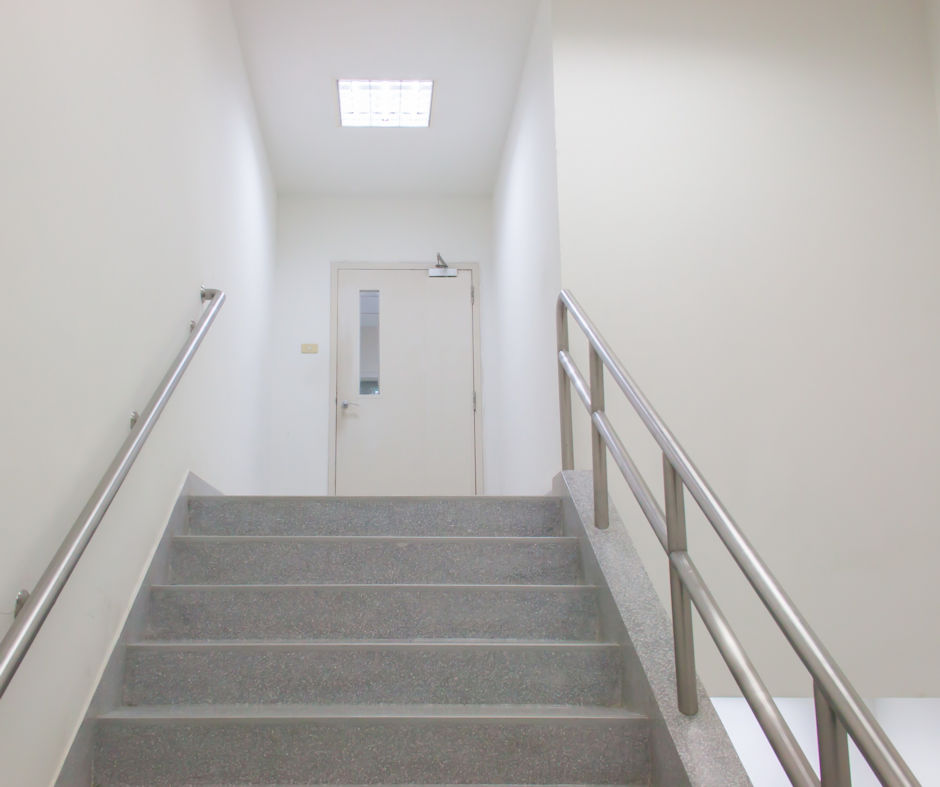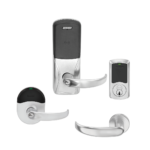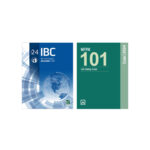The next article in my Decoded series addresses clarifications to the 2024 model codes related to stairwell reentry. These requirements ensure that building occupants can leave a stairwell if it becomes compromised during a fire.
This post will be published in Doors & Hardware


The 2024 model codes are now available, and will soon begin to be adopted by some states and local jurisdictions. While some of the changes made to these publications will not apply until the 2024 code is officially adopted in a project’s jurisdiction, others are clarifications that may be used right way to help with more consistent interpretations of the requirements. Several changes were made to the model code requirements that affect stairwell doors, and the mandates for reentry.
The International Building Code (IBC) and International Fire Code (IFC) require doors leading to a stairwell to allow building occupants to leave the stairwell if it becomes compromised during a fire by smoke and flames or by firefighters and equipment. To facilitate stairwell reentry, doors may have passage sets or fire exit hardware with non-locking lever trim (no lock on either side of the door), or doors may have electrified locks or electrified lever trim for fire exit hardware on the stairwell side. During a fire, the electrified lever on the stair side of the door is intended to be unlocked remotely without unlatching, allowing building occupants to open the door from within the stairwell to find another exit or wait for assistance.
According to the 2021 and prior editions of the I-Codes, electrically-locked stairwell doors are required to be unlocked by a switch located at the fire command center or inside the main entrance of the building. But what if the fire department has not yet arrived to activate the switch? And what happens to the locks if there is a loss of power? For this application, the hardware industry typically specifies and installs fail safe locks which automatically release upon loss of power, but the fail safe function was not specifically mandated by past editions of the code.
This was resolved in the 2024 I-Codes, where locks on the stair side of stairwell doors must be capable of being unlocked simultaneously without unlatching, when any of the following conditions occur:
- A signal from the fire command center, if present, or a signal by emergency personnel from a single location inside the building’s main entrance
- Activation of a fire alarm signal (where present) in an area served by the stairwell
- Power failure to the electric lock or locking system
Note that these requirements do not apply to stair discharge doors, which must be openable from the egress side and may be locked only from the opposite side. The I-Codes also include exceptions for buildings in certain use groups where a single exit stairway is permitted.
This change will ensure the highest level of safety with regard to stairwell reentry and will be consistent with what has already been an industry standard practice. In addition, it will align the fire alarm release requirement of the IBC and IFC with that of NFPA 101 – Life Safety Code. While NFPA 101 requires electrified locks to be unlocked upon activation of the fire alarm system, prior editions of the I-Codes did not reference fire alarm activation in this section and relied on the switch at the fire command center to be activated by fire department personnel.
The section of NFPA 101, Stair Enclosure Re-Entry, was not modified in the 2024 edition with regard to the release methods for electrified locks. The only change to this section was an added requirement for new installations: electromechanical or electromagnetic locking hardware must be listed in accordance with UL 294, Access Control System Units, or UL 1034, Burglary-Resistant Electric Locking Mechanisms. As with other code sections addressing special locking arrangements, changes made to the 2024 model codes allow products listed to either of these two standards.
The stairwell reentry requirements of the Life Safety Code differ from those of the I-Codes. According to NFPA 101, doors leading to the stairwell may be mechanically locked on the stair side if the stair is serving four stories or less. For stairs serving more than four stories, the doors may be locked electrically, but the levers on the stair side of the doors must unlock automatically upon initiation of the building fire alarm system (some occupancy chapters include exceptions). NFPA 101 also allows “selected reentry”, where the doors serving some floors are mechanically locked on the stair side, and some are not locked. Note that the I-Codes do not allow selected reentry or mechanical locks on stairs serving four stories or less.
For more information about the stairwell reentry requirements for a specific jurisdiction, refer to the adopted codes, or consult the Authority Having Jurisdiction.
You need to login or register to bookmark/favorite this content.









Leave A Comment